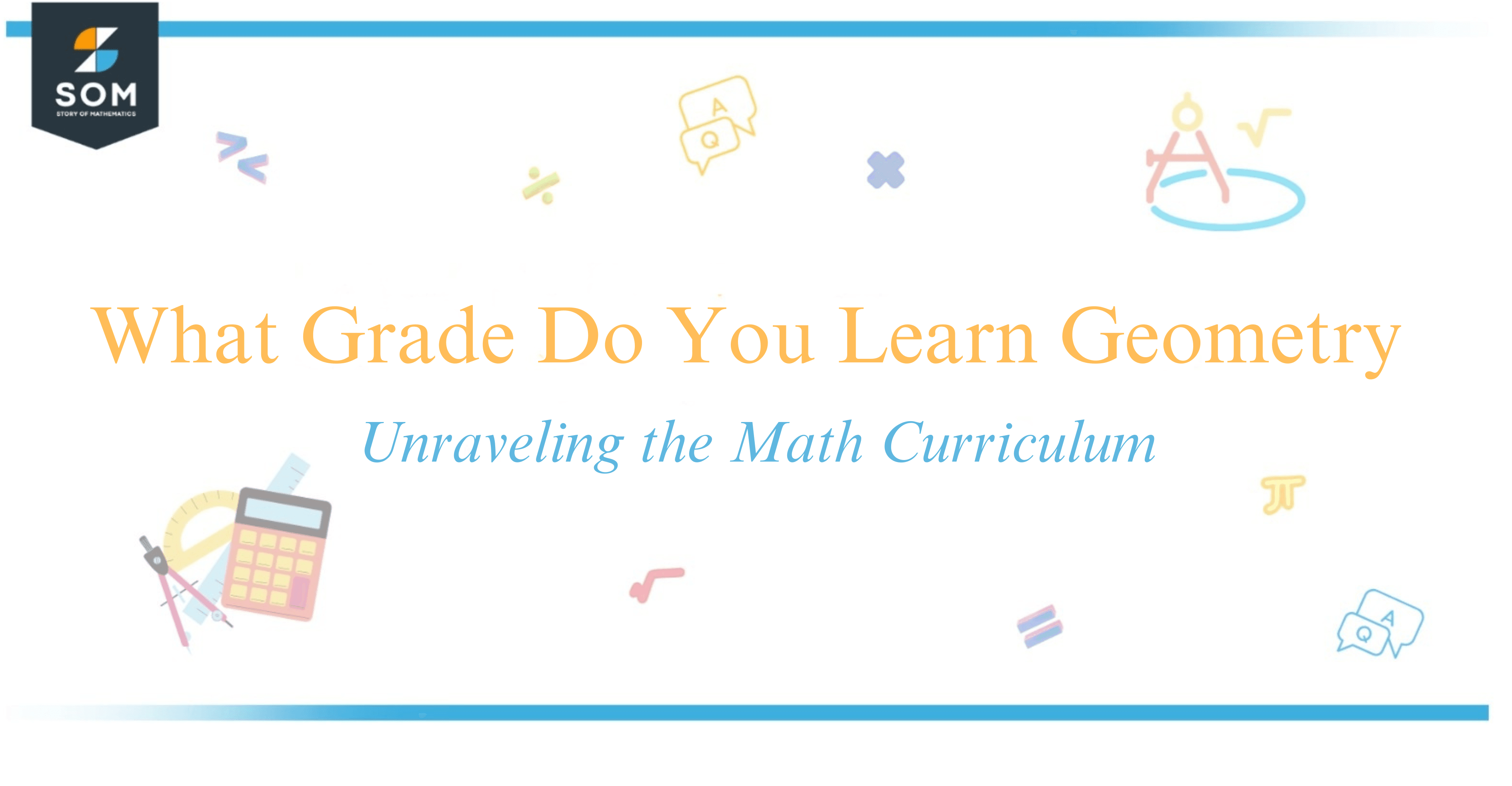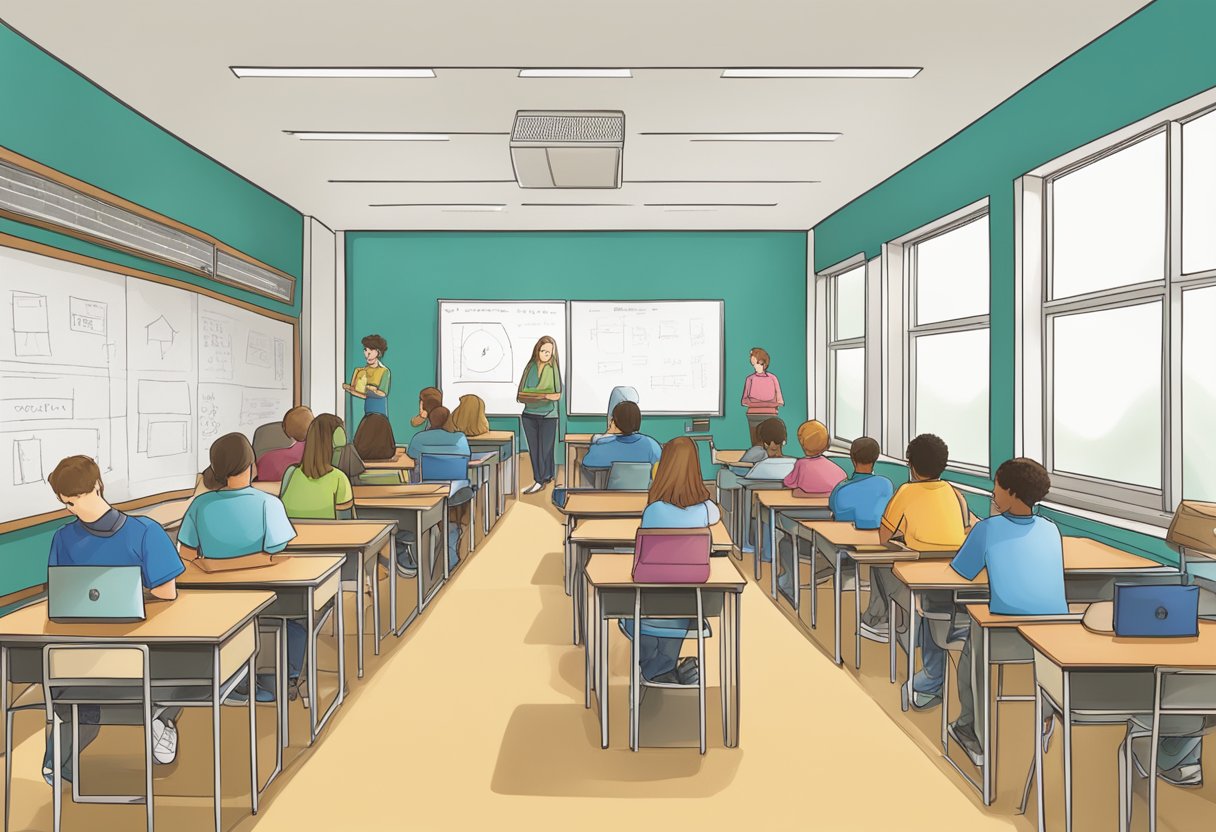JUMP TO TOPIC

Geometry is a branch of mathematics that I encounter at various stages of my education, with its foundational concepts often introduced as early as elementary school.
It’s fascinating how this subject weaves into almost every part of my curriculum, starting subtly in kindergarten with shapes and space, and becoming more defined through middle school and into high school.
In elementary, I started with basic shapes and advanced to more complex math concepts as I grew. In middle school, the focus shifted to a more formal study of geometry, where I began to explore the relationships between figures, the properties of space, and the theorems that govern these concepts.
By the time I reach high school, I’m fully immersed in the world of geometry, learning about transformations, congruence, similarity, right triangles, analytic geometry, and solid geometry.
This progression shows the layered approach to learning, ensuring that I build a strong foundation before tackling more intricate problems.
As I dive deeper into the subject, I discover that geometry is not just about learning shapes and sizes but also about honing my analytical and problem-solving skills, preparing me for a wide range of real-world applications.
Stay with me as we explore the captivating journey of learning geometry and how it unfolds across different stages of my education.
What Grade Geometry Is Learned In
In navigating the landscape of mathematics education, I’ve found that geometry often first appears in a formal setting around middle school.

However, the foundation for understanding shapes like circles, rectangles, and squares starts as early as elementary school. Recognizing shapes and basic properties, including angles and lines, introduces young learners to this critical branch of mathematics.
By Grade 7, students typically explore further into geometry, covering topics such as the computation of area, perimeter, volume, and surface area. The curriculum may introduce inequalities and measurements connected to various shapes.
| Grade | Geometry Concepts Covered |
|---|---|
| 7 | Inequalities, volume, and surface area of shapes |
| 8 | Linear functions, graphing, introductory algebra |
| 9 | Algebra I, progressing with geometry |
In high school, geometry becomes more structured, often being a significant part of the 9th-grade math or 10th-grade math curriculum, depending on the school system or country.
For example, in the United States, it’s common to encounter geometry in the 10th grade, aligned with the Common Core Standards.
High school students engage deeply with geometry, learning about polygons and complexes like the pentagon, and dive further into the relationships between shapes. They learn to calculate dimensions and understand the theoretical underpinnings of these math concepts.
Geometry‘s intersection with algebra becomes clearer as students work on fractions and deal with shapes in algebraic form. Through exploring and manipulating expressions, they develop a more profound comprehension of mathematics as a whole.
By grasping these math concepts, high schoolers build on their knowledge of geometry, preparing them for more advanced levels in college and beyond.
Middle School to High School Transition

As I transitioned from middle school to high school geometry, I noticed the differences in teaching styles and expectations.
My middle school geometry lessons were focused on the basics of shapes and sizes, adhering to the Common Core Standards. At this stage, concepts of congruence and similarity were introduced more intuitively, gearing me up for the high stakes in high school.
In high school, the approach to teaching geometry becomes more rigorous. My math skills were challenged as I began to explore deeper into axioms, theorems, and proofs.
The high school curriculum builds on middle school foundations, introducing advanced concepts such as transformations expressed in terms the formal language of mathematics: rotations ($R$), reflections ($F$), translations ($T$), and dilation ($D$).
I compiled a brief comparison to illustrate the progression:
| Middle School Geometry | High School Geometry |
|---|---|
| Basic shapes & sizes | Axioms and theorems |
| Intuitive understanding | Formal proofs and deductions |
| Congruence & Similarity | Precise definitions and applications |
In essence, the journey from middle school to high school mathematics can be seen as a natural progression, where the cornerstone laid in the earlier years comes to fruition.
My adaptation to the advanced principles of high school geometry was facilitated by the foundational skills acquired through the Common Core Standards in middle school. These early concepts provided the groundwork upon which my high school education could build a more comprehensive understanding of geometry.
Post-Secondary Geometry Concepts
In my journey beyond high school, I’ve discovered that geometry evolves substantially at the post-secondary level.
Unlike the foundational shapes and measurements I was used to, probability, trigonometry, the pre-calculus, and calculus come to the forefront, integrating geometric principles with advanced mathematical theories.
Trigonometry is the first step in this advanced exploration, where the study of triangles and the relationships between their angles and sides deepens.
Here, the focus is on functions like sine $( \sin )$, cosine $( \cos )$, and tangent $( \tan )$, crucial for solving problems involving right-angled triangles. For example, to determine the height of a tower, I might use the tangent function: $ \tan(\theta) = \frac{\text{opposite}}{\text{adjacent}}$.
Moving into pre-calculus, I’ve learned how this serves as a bridge to higher math, emphasizing functions, polynomials, and an array of graphing techniques.
Complex numbers and vectors add layers to my geometric understanding, providing the groundwork for the next mathematical leap.
Calculus takes geometry’s spatial concepts to new heights through limits, derivatives, and integrals.
It allows me to calculate things like the rate of change of a curve (a derivative) or the area under a curve (an integral), transforming my geometric knowledge into a dynamic tool. For instance, determining the maximum volume of a box would involve calculating the derivative of the volume function and finding where this derivative equals zero.
Finally, probability intertwines with geometry when predicting outcomes based on geometric figures. For example, finding the likelihood that a point within a circle is closer to the center than the edge involves integrating my understanding of area and likelihood, represented by the formula for the probability of an event A: $P(A) = \frac{\text{number of outcomes in A}}{\text{total number of possible outcomes}}$.
Geometry at this level is no longer limited to simple shape properties; it’s an intricate part of a vast mathematical landscape.
Conclusion
In my journey through the education system, I’ve seen that mathematics plays a fundamental role at every level. I learned that geometry begins as early as kindergarten and evolves in complexity through each grade.
By the time students reach middle school, particularly in the 5th and 6th grades, the focus intensifies on plane and solid geometric figures. It is in 8th-grade math that algebra and geometry intersect more noticeably, introducing linear functions and more advanced graphing.
When high school begins, geometry is typically explored in 10th grade, following Algebra I in 9th grade. This progression ensures that you have a solid foundation in algebra before advancing to geometric concepts.
In addition to learning about different types of shapes, 10th-grade math delves into proofs, theorems, and in-depth properties of shapes.
By the time I reached 11th grade, Algebra II built upon these foundations, weaving in geometry to help me understand algebraic functions better.
The beauty of mathematics is in its structure; each level builds upon the previous, creating a robust framework for understanding our world.
The skills learned in geometry are not just relevant to the classroom, but they extend to practical applications in daily life.
So, my experience has solidified my belief that mastering geometry is indeed an essential milestone in the mathematical journey of any student.
